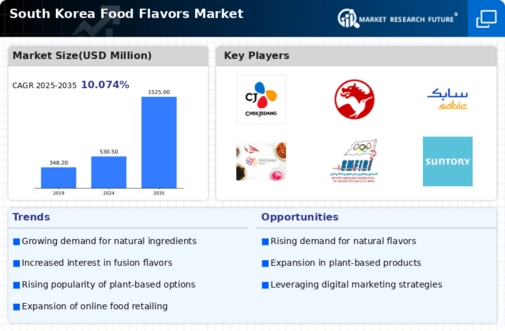Growing Popularity of Plant-Based Foods
The market in South Korea is significantly influenced by the growing popularity of plant-based foods. As more consumers adopt vegetarian and vegan diets, there is an increasing demand for flavors that complement plant-based ingredients. This shift is reflected in the rise of plant-based meat alternatives and dairy substitutes, which require innovative flavor solutions to enhance their taste profiles. The market for plant-based foods is expected to grow by 20% annually, creating new opportunities for flavor manufacturers to develop products that cater to this segment. Consequently, the food flavors market is adapting to these changes, focusing on creating flavors that resonate with health-conscious consumers seeking plant-based options.
Increased Focus on Clean Label Products
In South Korea, there is a growing consumer preference for clean label products, which significantly impacts the food flavors market. Consumers are becoming more health-conscious and are actively seeking products with transparent ingredient lists. This trend has led to an increased demand for natural and organic flavoring solutions, as consumers perceive them to be healthier alternatives. According to recent surveys, approximately 70% of South Korean consumers express a preference for products that contain no artificial flavors. This shift towards clean label products compels manufacturers to reformulate their offerings, thereby driving innovation in the food flavors market and encouraging the development of natural flavoring solutions.
Adoption of Advanced Flavor Technologies
The food flavors market in South Korea is witnessing a surge in the adoption of advanced flavor technologies. Innovations such as encapsulation and microencapsulation techniques allow for enhanced flavor delivery and stability in various food applications. These technologies enable manufacturers to create flavors that are more potent and longer-lasting, which is particularly appealing to food producers aiming to improve product quality. As the market evolves, the integration of these advanced technologies is likely to become a key differentiator among flavor suppliers. This trend not only enhances the sensory experience of food products but also positions the food flavors market for sustained growth in the coming years.
Rising Demand for Unique Flavor Profiles
The food flavors market in South Korea experiences a notable increase in demand for unique and exotic flavor profiles. Consumers are increasingly seeking diverse taste experiences, which drives manufacturers to innovate and expand their flavor offerings. This trend is reflected in the growing popularity of fusion cuisines that blend traditional Korean flavors with international influences. As a result, the market for food flavors is projected to grow at a CAGR of approximately 6.5% over the next five years. This rising demand for unique flavor profiles compels companies to invest in research and development, thereby enhancing their product portfolios and catering to the evolving preferences of consumers.
Expansion of the Food and Beverage Sector
The market in South Korea benefits from the continuous expansion of the food and beverage sector. With a robust economy and increasing disposable incomes, consumers are willing to spend more on premium food products. The food and beverage industry is projected to reach a market value of $100 billion by 2026, which directly influences the demand for innovative flavor solutions. This growth encourages flavor manufacturers to collaborate with food producers to create tailored flavor profiles that meet specific consumer needs. Consequently, the expansion of the food and beverage sector serves as a significant driver for the food flavors market, fostering innovation and competition among flavor suppliers.





















Leave a Comment